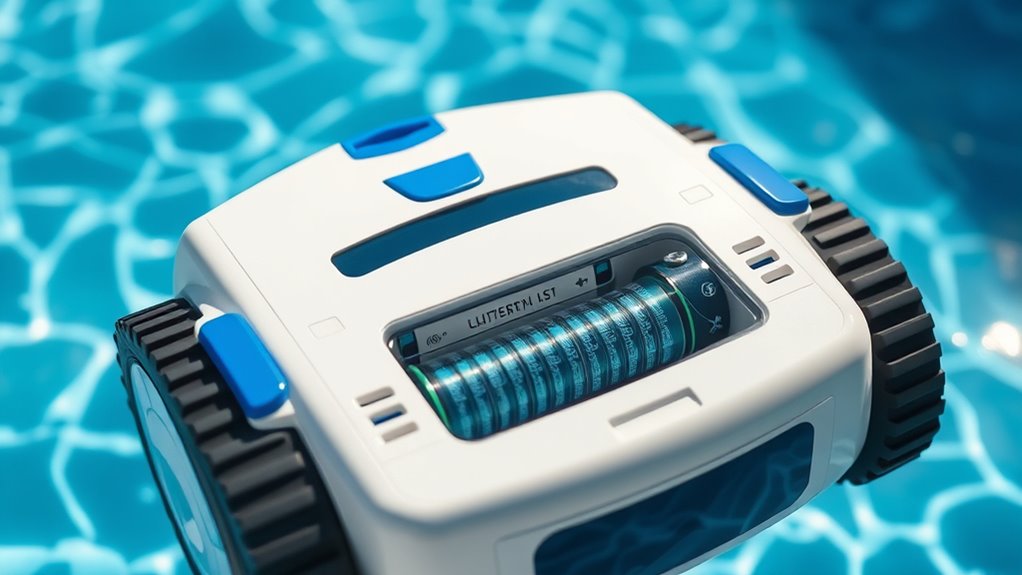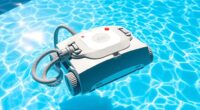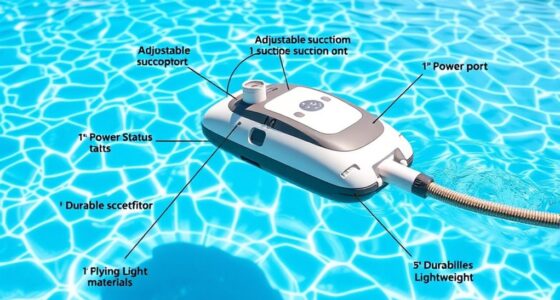To keep your cordless robotic pool cleaner’s battery in top shape, understand its type and follow proper charging routines. Always unplug the charger after it’s full, charge before the battery drops too low, and avoid continuous plugging. Store batteries in a cool, dry place with a partial charge, and monitor their health regularly. Proper handling and maintenance can extend your battery’s lifespan, and if you want detailed tips, there’s more to explore.
Key Takeaways
- Use recommended chargers and unplug once the battery is fully charged to prevent overcharging.
- Store batteries in a cool, dry place with 50-70% charge for optimal longevity.
- Regularly monitor battery health and performance using manufacturer tools or display panels.
- Avoid exposing batteries to extreme temperatures or water during storage and maintenance.
- Recycle damaged or non-charging batteries responsibly to ensure eco-friendly disposal.
Understanding Your Battery Type and Specifications
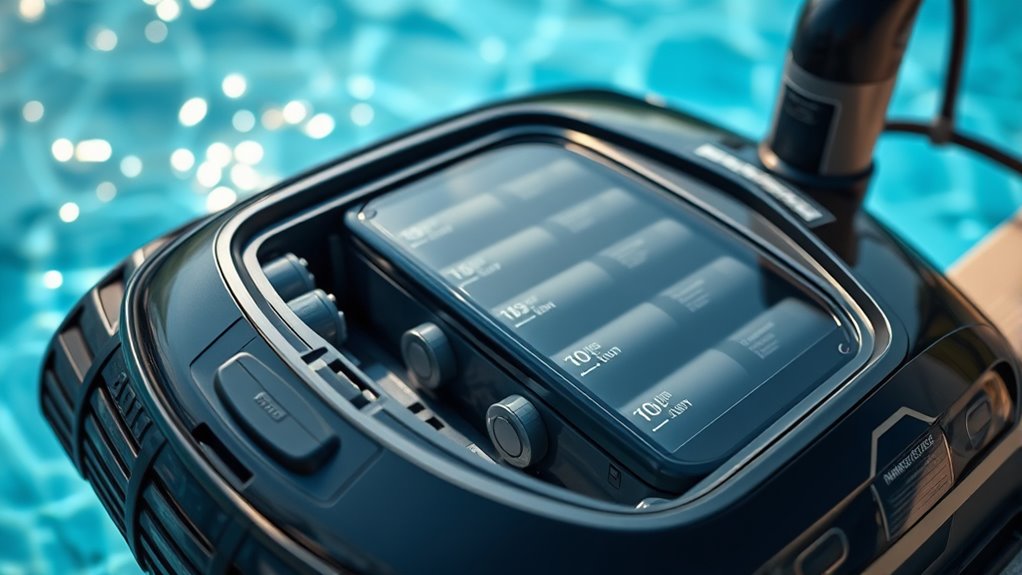
Have you ever wondered what kind of battery powers your cordless robotic pool cleaner? Knowing your battery’s chemistry is essential, as it determines how it performs and how you should care for it. Most pool cleaners use lithium-ion or nickel-metal hydride batteries, each with different characteristics. Check the voltage specifications on your battery or device label—common ratings range from 12V to 36V—and ensure compatibility with your cleaner. Understanding these details helps you avoid using incompatible chargers or overtaxing the battery. By familiarizing yourself with your battery’s chemistry and voltage specs, you gain better insight into its capacity, lifespan, and safety considerations, helping you optimize performance and prolong its life.
Proper Charging Practices for Longevity
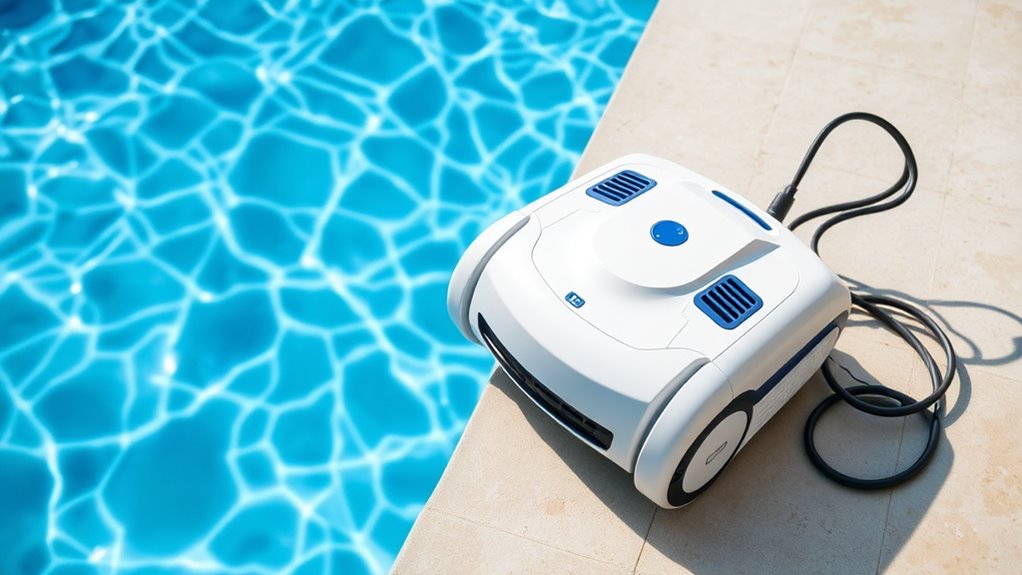
Once you’re familiar with your battery’s specifications, practicing proper charging habits can considerably extend its lifespan. To preserve battery capacity, avoid overcharging by unplugging once it reaches full charge. Keep track of charging cycles, as each cycle slightly reduces overall capacity. It’s best to charge your robotic pool cleaner when the battery drops to around 20-30%, preventing deep discharges that can harm the battery. Use the recommended charger and avoid using third-party adapters, which may not regulate power properly. Don’t leave the battery plugged in continuously, as constant trickle charging can degrade it over time. Regular, mindful charging habits help maintain ideal battery capacity and prolong the number of charging cycles your battery can handle, ensuring your cleaner works efficiently for years to come. Additionally, understanding the contrast ratio of your battery’s performance can help you optimize your charging schedule for maximum longevity. Being aware of battery health and monitoring its condition periodically can also provide insights into when it might need replacement or maintenance. Proper storage when not in use for extended periods can further prevent capacity loss and maintain overall battery performance. Incorporating routine battery maintenance checks can help identify early signs of deterioration and prevent unexpected failures.
Storage Tips When Not in Use
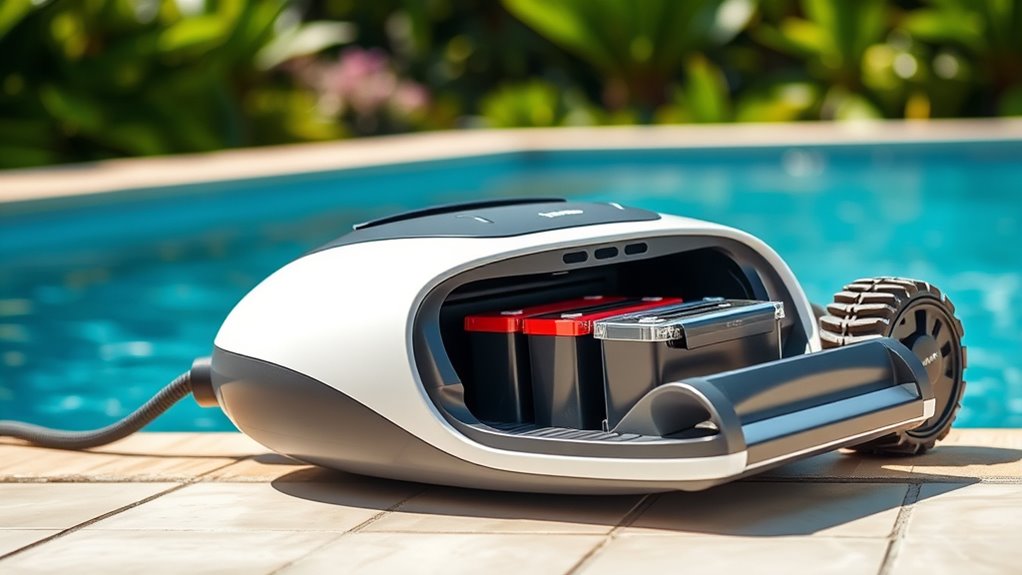
When you’re not using your robotic pool cleaner, proper storage is essential to keep the battery in good condition. Store the device in a cool, dry place away from direct sunlight and extreme temperatures, which can degrade the battery over time. Before storing, ensure the battery has a partial charge, around 50-70%, to prevent capacity loss. If the battery is damaged or no longer holds a charge, don’t discard it in the trash. Instead, look into recycling options or battery disposal programs in your area. Many communities offer designated recycling centers for electronic waste, including batteries. Proper disposal and recycling help protect the environment and ensure safe handling of hazardous materials. Regularly inspecting your battery for signs of wear can help you identify issues early and maintain optimal performance. Taking these steps preserves your battery’s lifespan and supports eco-friendly practices.
Monitoring Battery Health and Performance
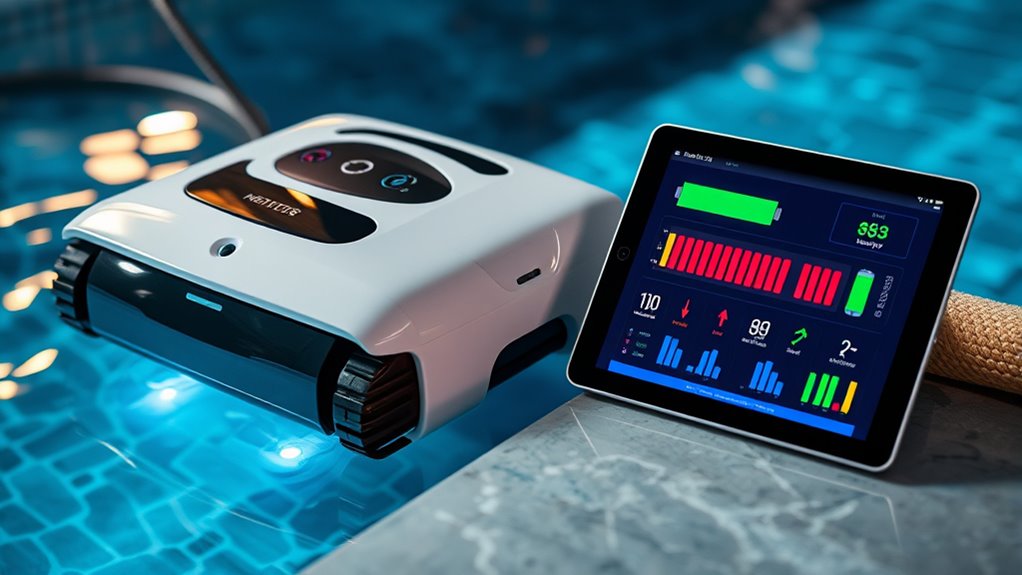
Regularly monitoring your robotic pool cleaner’s battery health helps guarantee it performs at its best over time. Keep an eye on signs of battery degradation, like reduced runtime or longer charging times, which indicate the battery’s capacity is declining. Implement effective power cycle management by allowing the battery to fully discharge and recharge periodically; this helps maintain ideal performance and prevents capacity loss. Use the manufacturer’s app or display panel to track battery performance metrics, and note any unusual drops in power or efficiency. Staying proactive ensures you catch early signs of wear, prolongs battery lifespan, and avoids unexpected breakdowns. Additionally, understanding battery maintenance best practices can further enhance longevity. Staying proactive ensures you catch early signs of wear, prolongs battery lifespan, and avoids unexpected breakdowns. Consistent monitoring allows you to schedule timely maintenance or replacement, ultimately keeping your pool cleaner operating smoothly for years to come. Furthermore, keeping the battery temperature within recommended ranges can prevent overheating and extend battery life. Incorporating smart monitoring tools can also provide real-time data, enabling more precise management of your battery’s health.
Troubleshooting Common Battery Issues

If your pool cleaner’s battery isn’t lasting as long as it used to, or if charging problems keep happening, it’s time to troubleshoot. You might need to check for signs of battery life reduction, persistent charging issues, or improper storage habits. Addressing these common issues can help keep your cleaner running smoothly. Regular maintenance, such as proper battery disposal practices, can also extend the lifespan of your cordless robotic pool cleaner’s battery. Additionally, ensuring your device is stored in a climate-controlled environment can prevent premature battery degradation. Proper battery maintenance techniques are essential for maintaining optimal performance and longevity. Incorporating advanced fraud detection techniques for your device security can further protect your investment from unauthorized access. Being aware of battery safety guidelines is also crucial to prevent potential hazards during charging or disposal.
Battery Life Reduction
Battery life can decline over time due to improper charging habits or exposure to extreme temperatures. Repeated charging cycles cause battery degradation, reducing overall capacity and runtime. If you frequently overcharge or let the battery fully discharge, it accelerates wear and diminishes its lifespan. Similarly, exposing your robotic pool cleaner to high heat or cold can damage the battery’s internal chemistry, leading to faster deterioration. To maximize battery life, avoid charging beyond 100% or leaving it empty for extended periods. Regularly monitor the charging process and keep the device in a moderate environment. Proper care during charging cycles ensures the battery maintains ideal performance longer, preventing premature reduction in runtime and avoiding costly replacements. Additionally, being mindful of battery maintenance practices can significantly extend the overall lifespan of your cordless robotic pool cleaner’s battery.
Charging Problems Persist
Are you experiencing persistent charging issues with your robotic pool cleaner? These problems often stem from the battery chemistry’s limitations or excessive charging cycles. Over time, repeated charging cycles can degrade the battery’s capacity, making it difficult to hold a full charge. If your device isn’t charging properly, check for signs of wear or damage to the charging contacts. Also, make sure you’re not overcharging the battery, as this can harm the chemistry and reduce lifespan. Using the correct charger and following manufacturer guidelines helps maintain ideal battery health. Properly managing charging cycles and understanding battery chemistry can prevent persistent issues and extend your cleaner’s performance. Additionally, understanding battery maintenance practices can further help preserve the battery’s longevity. Being aware of charging best practices can also significantly reduce the risk of damage. Regularly monitoring the battery’s condition and avoiding extreme temperatures can further support optimal battery performance. For optimal results, some models include built-in battery protection features that safeguard against overcharging and overheating. If problems continue, it might be time to replace the battery or consult the manufacturer for advice.
Storage and Maintenance
Proper storage and maintenance are essential to prevent common battery issues and keep your robotic pool cleaner working efficiently. When not in use, store the battery in a cool, dry place, away from direct sunlight to prevent capacity loss. Regularly clean connections and inspect for corrosion or damage. To avoid harming the environment, always recycle your battery properly through designated battery recycling programs—never discard it in the trash. Proper maintenance not only extends battery life but also minimizes environmental impact, reducing hazardous waste. Keep track of charging cycles and avoid overcharging or deep discharges. By handling batteries responsibly and storing them correctly, you ensure your pool cleaner’s longevity and support eco-friendly disposal practices. Additionally, monitoring battery angles and ensuring proper alignment can help maintain optimal performance and prolong the lifespan of your batteries. Regularly checking battery health can alert you to potential issues before they become serious problems. Using the correct charger compatibility can also prevent damage and improve charging efficiency. Maintaining proper battery temperature during charging and storage further helps preserve battery capacity and longevity. Incorporating battery management strategies can optimize overall performance and prevent premature failure.
Tips for Extending Battery Lifespan
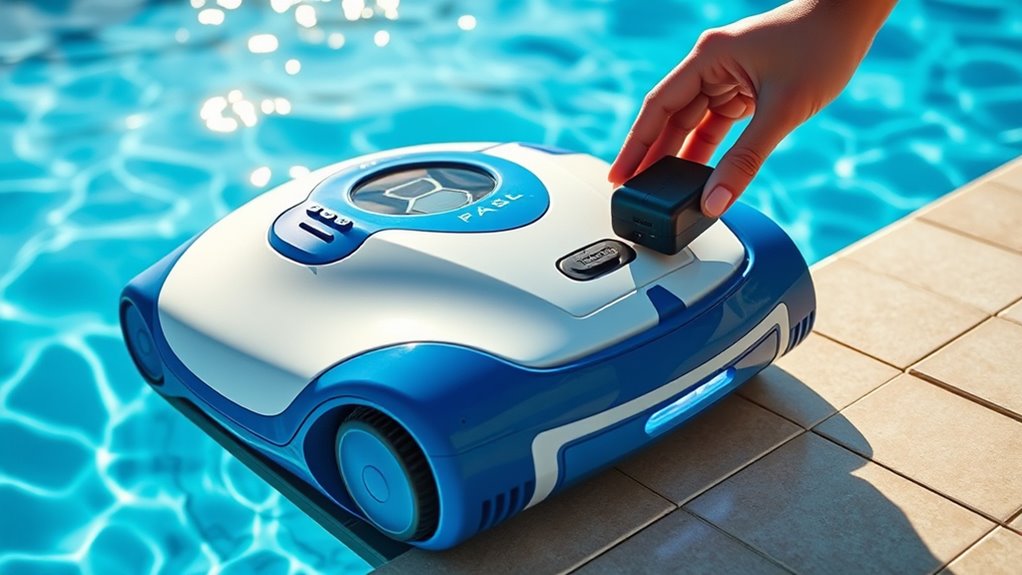
To maximize the lifespan of your cordless robotic pool cleaner’s battery, it’s essential to follow some simple yet effective tips. First, verify your device’s solar compatibility, if available, to help maintain the battery charge naturally when exposed to sunlight. Avoid overcharging by disconnecting the charger once fully charged, which prevents unnecessary strain. Keep the cleaner’s water resistance features in mind—protect the battery from water exposure during storage or maintenance to prevent damage. Regularly monitor the battery’s temperature, avoiding extreme heat or cold, as this can shorten its life. Additionally, store the cleaner in a cool, dry place when not in use, and follow the manufacturer’s guidelines for charging cycles. Proper battery maintenance is crucial for ensuring long-term performance and safety. Being aware of battery capacity can help optimize charging routines and prevent premature battery failure. These practices help extend your battery’s overall lifespan and ensure peak performance.
Frequently Asked Questions
How Often Should I Replace the Battery in My Robotic Pool Cleaner?
You might wonder how often to replace the battery in your robotic pool cleaner. Typically, battery replacement intervals depend on usage, but most batteries last about 1-2 years. Keep an eye on performance; if your cleaner struggles or takes longer, it’s time for a new battery. Remember to follow battery recycling guidelines when replacing it, ensuring safe disposal and environmental responsibility. Regular maintenance helps extend your device’s lifespan.
Is It Safe to Leave the Battery Charging Overnight?
Did you know that over 60% of pool owners leave their robotic cleaner charging overnight? While it might seem safe, improper charging can impact battery longevity and pose safety risks. You should always check your charger’s instructions for proper charging safety. To maximize battery life, avoid overcharging. If you follow these tips, leaving it overnight is generally safe, but always prioritize manufacturer guidelines to protect your device and safety.
Can I Use Any Charger for My Robotic Pool Cleaner’s Battery?
You shouldn’t use any charger for your robotic pool cleaner’s battery; charger compatibility is essential. Using an incompatible charger can compromise battery safety, risking damage or hazards. Always check the manufacturer’s recommended charger specifications, including voltage and current ratings. This guarantees safe charging, preserves battery life, and prevents potential malfunctions. Stick to the original charger or approved replacements to keep your pool cleaner operating smoothly and safely.
What Signs Indicate My Battery Needs Professional Servicing?
Your battery’s like a loyal companion—pay attention to its signals. If it overheats, feels excessively warm, or shows signs of swelling, it’s crying out for help. Swelling or bulging indicates internal damage, risking leaks or fires. These signs mean your battery needs professional servicing immediately. Ignoring them can turn a small issue into a dangerous situation, so don’t delay—trust the experts to handle it safely and keep your pool robot running smoothly.
How Does Temperature Affect My Battery’S Performance and Lifespan?
Temperature affects your battery’s performance and lifespan because of its temperature sensitivity. High temperatures can accelerate battery degradation, shortening its life and reducing efficiency, while cold temperatures may decrease capacity temporarily. To protect your battery, avoid exposing it to extreme heat or cold for extended periods. Keeping it in a moderate environment helps maintain ideal performance and prolongs its lifespan, ensuring your cordless robotic pool cleaner works reliably whenever you need it.
Conclusion
Think of your cordless robotic pool cleaner’s battery as a delicate garden. With proper care—watering it through correct charging, pruning it by storing wisely, and tending to its health—you’ll guarantee it blooms season after season. Neglect, however, is like a drought that stunts growth. By nurturing your battery with patience and attention, you’ll keep your cleaner thriving, turning maintenance into a dance of harmony that keeps your pool sparkling and your summer carefree.
